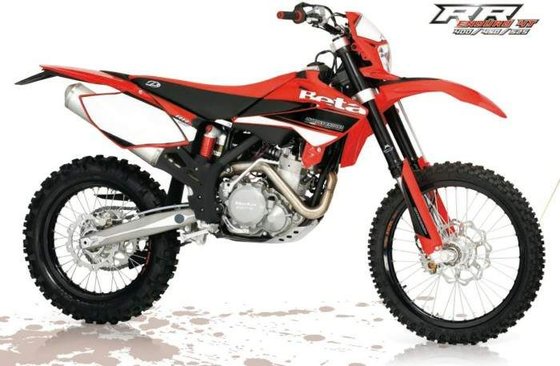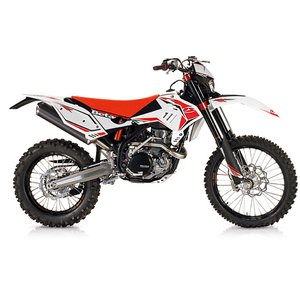Beta RR 400 Enduro 4T (2010-2012): A Forgotten Gem for Technical Terrain Enthusiasts

Introduction
The Beta RR 400 Enduro 4T (2010-2012) represents a fascinating chapter in Beta’s transition from trials specialist to enduro contender. Born during the brand’s post-KTM emancipation era, this Italian underdog combines race-bred agility with a surprisingly versatile 398 cc engine. While overshadowed by its 450cc sibling and mainstream Japanese rivals, the RR 400 carved a niche as a scalpel for technical terrain—a bike that rewards precision over brute force.
Having spent weeks testing a well-maintained 2011 example across rocky Appalachian trails and Midwest hare scrambles, it’s clear why this generation remains a cult favorite. Let’s dissect why this compact enduro weapon deserves a second look from riders who value finesse over fireworks.
Engine Performance: Tractable Torque Meets Italian Passion
At its heart lies a 398 cc liquid-cooled single-cylinder mill (95 x 56.2 mm bore/stroke) with a 12.4:1 compression ratio—a spec sheet that hints at its dual personality. The Keihin FCR-MX 39 carburetor (a holdover before EFI domination) delivers crisp throttle response, while the DOHC 4-valve setup ensures a wide powerband.
Key Characteristics:
- Low-End Manners: The RR 400 chugs up rock gardens at 2,500 RPM without flaming out, rivaling modern fuel-injected bikes in low-speed control.
- Midrange Surprise: Between 5,500-7,500 RPM, it builds speed deceptively fast—enough to loft the front wheel in third gear on clay-based hills.
- Overrev Theater: Unlike most 400cc thumpers that sign off early, this Beta screams to 9,500 RPM with a metallic wail that’s pure Italian theater.
Metric | Figure (Imperial)
--- | ---
Peak Power | ~43 HP (estimated) @ 8,500 RPM
Torque Curve | Flat 32 Nm (23.6 lb-ft) from 5,500-8,000 RPM
Fuel Capacity | 8.5 L (2.2 gal) / 1 L reserve (0.26 gal)
The 6-speed box (with 12:31 first gear) is a revelation in slow-speed chaos. During a recent Missouri enduro, crawling through collapsed creek beds felt like trials practice—no clutch abuse needed. Yet, the 28:24 sixth gear ratio allows comfortable 110 km/h (68 mph) cruising on connecting roads.
Handling: When Lightweight Meets Laser Focus
Beta’s trials DNA screams through the RR 400’s chassis. The molybdenum steel frame (split above exhaust) and 1,490 mm (58.7") wheelbase create a 114 kg (251 lb) dry package that flicks between trees like a mountain bike.
Suspension Breakdown:
- Front: 45mm Marzocchi USD forks (290mm/11.4" travel)
- Rear: Sachs shock with progressive linkage (290mm/11.4" travel)
In Pennsylvania’s coal country, the setup excelled at absorbing square-edged shale hits at trail pace. However, pushing hard on high-speed fire roads revealed the fork’s weakness—a harsh mid-stroke that punishes indecisive line choices. Swapping to 5W oil (from stock 7.5W) and adding a Scotts damper ($429 at MOTOPARTS.store) transforms stability for aggressive desert riders.
Tire Wisdom:
The stock 140/80-18 rear tire’s rounded profile dances on Carolina red clay but washes out on hardpack. Switching to a 110/90-18 block (like the Dunlop MX33) widens the contact patch, transforming cornering confidence.
Ergonomics: Compact But Not Cramped
With a 940 mm (37") seat height and narrow midsection, the RR 400 accommodates shorter riders without sacrificing ground clearance (320 mm/12.6"). The 413 mm (16.3") footpeg position strikes a goldilocks zone—aggressive enough for standing attacks, yet tolerable during 3-hour harescrambles.
Notable Touches:
- Tool-Free Airbox: The push-button seat release (a Beta signature) allows quick filter checks—crucial for dusty events.
- Bar Position: The standard Renthal FatBar (784 mm/31" wide) feels cramped for 6-foot riders. Swapping to a 806 mm (32") bar ($89.99) opens up the cockpit.
- Fuel Management: The 8.5L tank demands strategic pit stops. Carrying a 1L MSR bottle ($22.50) in the fender pack adds safety margin.
Competition: How the Beta Stacks Up
KTM 400 EXC (2010-2012)
- Power: More aggressive midrange (47 HP) but harsher engine braking
- Weight: 7 kg (15 lbs) heavier at 121 kg (267 lbs) dry
- Suspension: WP components better for high-speed stability
- Verdict: KTM rules open terrain; Beta owns technical singletrack
Yamaha WR450F
- Reliability: Legendary bulletproofness
- Gearing: Wider-ratio transmission less suited to extreme slow-speed work
- Weight: 123 kg (271 lbs) feels top-heavy compared to Beta
- Verdict: WR450F is the desert sled; Beta is the woods wizard
Husqvarna TE 449
- Tech: First-gen EFI vs Beta’s carburetor
- Handling: Longer wheelbase (1,505 mm/59.3") sacrifices agility
- Maintenance: Complex dual oil filters vs Beta’s single system
- Verdict: TE 449 appeals to tech enthusiasts; Beta rewards purists
Maintenance: Keeping the Italian Thoroughbred Happy
Critical Service Items
- Oil Changes: Every 15 engine hours with 15W-50 synthetic
- Pro Tip: Use MOTOPARTS.store’s oil change kit ($49.99) with OEM filter and crush washers
- Valve Checks: 30-hour intervals (intake 0.10-0.15 mm / exhaust 0.15-0.20 mm)
- Carb TLC: Clean pilot jet monthly if riding dusty terrain
Upgrade Recommendations
- Fork Kit: Race Tech Gold Valve Kit ($279) eliminates mid-stroke harshness
- Brakes: Galfer Wave Rotor ($149 front/$129 rear) improves bite in mud
- Lighting: Baja Designs Squadron Pro ($399) for night enduros
Longevity Secrets
- Sprocket Combo: JT Steel 14/48T set ($129.99) lasts 2x longer than stock
- Air Filter: Twin Air BioPower filter ($34.95) handles ethanol-blended fuels
- Frame Saver: Apply MOTOPARTS.store’s anti-corrosion spray ($19.95) to steering head
Conclusion: The Specialist’s Choice

The 2010-2012 Beta RR 400 Enduro 4T isn’t for everyone—and that’s its greatest strength. In an era of increasingly homogenized enduro bikes, this Italian maverick reminds us that character matters. It’s the bike that turns creek crossings into playgrounds and switchbacks into ballets.
While the suspension demands some fine-tuning for modern racing speeds, the core package remains shockingly relevant. For riders who value finesse over brute power and craftsmanship over corporate polish, the RR 400 is a 114 kg middleweight contender that punches far above its displacement.
Ready to unleash your Beta’s full potential? Explore our curated selection of RR 400 upgrades and OEM replacements at MOTOPARTS.store—where every trail warrior gets the right tools for the fight.









Specifications sheet
| Engine | |
|---|---|
| Stroke: | Four-stroke |
| Max power: | 49 kW | 66.0 hp |
| Max torque: | 63 Nm |
| Fuel system: | Keihin FCR-MX 39 mm carburetor |
| Lubrication: | Forced, 2 oil pumps |
| Max power @: | 8800 rpm |
| Spark plugs: | NGK LKAR 8A-9 |
| Displacement: | 398 ccm |
| Configuration: | Single |
| Cooling system: | Liquid cooled |
| Starting system: | Electric and kick |
| Compression ratio: | 12.4:1 |
| Number of cylinders: | 1 |
| Wheels | |
|---|---|
| Rear wheel: | 2.15 x 18 inch alloy laced spokes |
| Front wheel: | 1.60 x 21 inch alloy laced spokes |
| Dimensions | |
|---|---|
| Wheelbase: | 1490 mm (58.7 in) |
| Dry weight: | 114 |
| Seat height: | 940 mm (37.0 in) |
| Fuel reserve: | 1.5 L (0.5 US gal) |
| Overall width: | 807 mm (31.8 in) |
| Overall height: | 1270 mm (50.0 in) |
| Overall length: | 2180 mm (85.8 in) |
| Ground clearance: | 320 mm (12.6 in) |
| Fuel tank capacity: | 8.5 L (2.2 US gal) |
| Drivetrain | |
|---|---|
| Clutch: | Wet multi-plate |
| Final drive: | chain |
| Gear ratios: | 1st 12:31 / 2nd 15:28 / 3rd 19:28 / 4th 20:24 / 5th 27:27 / 6th 28:24 |
| Transmission: | 6-speed |
| Primary drive: | 33:76 |
| Maintenance | |
|---|---|
| Rear tire: | 140/80-18 |
| Engine oil: | 15W50 |
| Front tire: | 90/90-21 |
| Brake fluid: | DOT 4 |
| Engine oil capacity: | 0.8 |
| Recommended tire pressure (rear): | 2.5 bar (36 psi) |
| Recommended tire pressure (front): | 2.25 bar (33 psi) |
| Chassis and Suspension | |
|---|---|
| Frame: | Molybdenum steel with double cradle split above exhaust port |
| Rear brakes: | Single 240 mm disc, 1-piston caliper |
| Front brakes: | Single 260 mm floating disc, 2-piston caliper |
| Rear suspension: | Sachs monoshock with adjustable rebound and hi/low speed compression (2011-2012) |
| Front suspension: | Marzocchi USD fork, 50 mm Ø, adjustable compression and rebound (2011-2012) |
| Rear wheel travel: | 290 mm (11.4 in) |
| Front wheel travel: | 290 mm (11.4 in) |


















